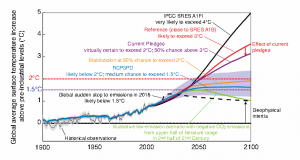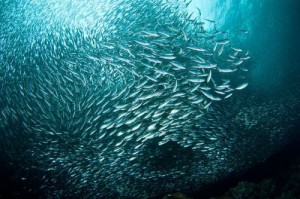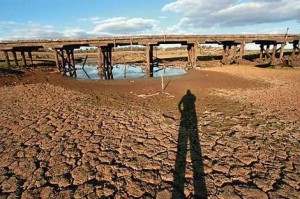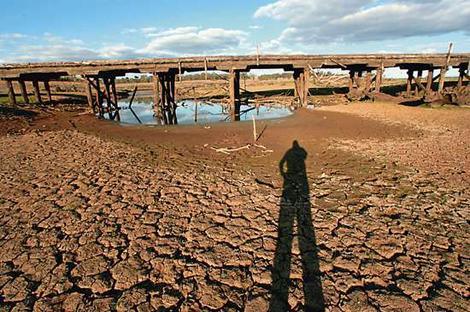I hate to do this to you on a Monday morning but three stories caught my eye this last week. The first one could be called a doomsday warning. The second deals with conclusions about ocean biodiversity drawn from a study. And the third is a statement acknowledging that traditional ranching practices are no longer working in the United States. What do all three stories have in common? Climate change.
Whether you believe global warming is natural variability in our geological history, or human induced caused by our love of fossil fuels and meat (methane from cows), or the beginning of the “End of Days,” one thing is abundantly clear – we are witnessing trends that point to an altered scenario for life on the planet and we have little choice but to seek solutions, something for which our political leaders have demonstrated little appetite. We on the planet can do something to mitigate the risk by, one, adapting to our new circumstances by altering us, our crops, and our animals(some of this sounds silly but one recent scientific study on genetic modification suggested this with a little bit of tongue in cheek), or by changing consumption patterns, conserving energy and altering our infrastructure to make it greener. What we cannot do is pretend not to see what is apparent before our eyes.
So what were the stories that have motivated this update?
World Bank Warns of the 4 Degree Celsius Threshold
For those who live in the world of Fahrenheit, 4 Celsius translates to 7.2 Fahrenheit. And the World Bank is talking about a mean temperature in its warning. Mean is a median. The range of temperature we will experience in this 4 Celsius scenario could see daytime temperatures 10-15 Celsius (18 to 27 Fahrenheit) higher in tropical areas of the planet although polar regions will probably experience the largest increases.
The bank’s doomsday scenario is prophetic. In it the threshold for widespread crop failure, malnutrition, mass migration and rising sea levels comes if we allow temperatures to rise by 4 Celsius. Most nations that are signatories to the Kyoto Protocol and other international climate initiatives have set a holding target of half of 4 Celsius. But the World Bank study is pessimistic and believes that we more than likely will see, based on current CO2 emissions, an increase of 3 to 3.5 Celsius (5.4 to 6.3 Fahrenheit) by 2100.
So although 4 Celsius is not a forecast it is a prophetic warning that we cannot let global warming continue without taking action that involves considerable self sacrifice. Because even a temperature rise of 2 Celsius will lead to significant alterations in land use, sea level and precipitation patterns.

In this doomsday scenario what is most notable is the areas most impacted are parts of the Developing World, already experiencing population growth and food shortages. Adding uncertainty in rainfall, weather patterns, river flow and the impact of rising sea levels on coastal populations, we see significant disruption not only to humans but to ecosystems within these nations. The most prophetic statement in the Bank’s report is this: “There is no certainty that adaptation to a 4 Celsius world is possible.”
Caribbean Fishery Collapse Linked to Climate Change
I love sardines. But they don’t seem to like global climate change as indicated by joint research done by Venezuela and the United States looking at the collapse of the sardine fishery in the Southern Caribbean Sea over the last decade. The collapse is directly attributed to a drop in plankton levels combined with overfishing. Catches have been reduced by 87% based on measurements over a 14-year period. The collapse in plankton correlates changes in water circulation patterns, salinity levels, acidification from absorbed CO2, and water temperature rises of 1.1 Celsius (2 Fahrenheit). The most likely causes – human-made climate change or natural climate variation. The only way to rule which is to continue studying the trends. Unfortunately that does little for those dependent on sardines. The Venezuelan sardine catch was 200,000 tons in 2004. Today it is 40,000 tons.

If human behaviour is the reason for fewer sardines, whether because of global warming, or overfishing, it is clear that humans can provide the solution.
American Ranchers in the West Are Adapting to an Unpredictable Future
The results of a survey of ranch managers in Southern Colorado done last year indicated that 25% planned to leave the industry because of persistent drought. Among ranchers that also practiced irrigated farming the number was higher at 36%. The reasons for such high levels of pessimism are prolonged drought, the high cost of replacement cattle, the inability to grow enough feed, and the low return on cattle they sell.
Ranchers report conditions not seen in their lifetimes. Scientists concur by providing weather data that shows extreme gyrations with searing heat and drought in one year followed by soil-eroding, crop-destroying torrential rains. It is a bag of extreme weather events happening with increasing frequency.
To mitigate against these altered weather patterns ranchers that are staying in the business are looking at genetically modifying the cattle they breed to withstand climate extremes. They also are altering the management of range land and feed crops they grow.
Colorado is symptomatic of a larger problem in the U.S. Cattle inventories in 2011 sank to their lowest levels since 1952. And the pervasive drought that hit much of the farm and ranching belt in the country was described as the most extensive since the 1950s, impacting 80% of agricultural lands across the country.

What are the Lessons Learned?
For all of us on this planet including the non-humans, we must find a collective voice to motivate those who govern us to attack the climate change file by instituting the changes needed to alter the outcome. Governments, manufacturers, inventors, and consumers – all have a strategic role to play to ensure the planet that emerges in 2100 will not be the one prophesied by the World Bank’s doomsday scenario.
Awareness is the first step. A call to action comes next followed by execution. I encourage you, my readers, to get involved in the conversation and together we can collectively create the actions that will alter the future.










Len Says: “The collapse in plankton correlates changes in water circulation patterns, salinity levels, acidification from absorbed CO2, and water temperature rises of 1.1 Celsius (2 Fahrenheit). The most likely causes – human-made climate change or natural climate variation. ”
While I rarely eat sardines, I share your alarm over the plankton decline, which seems roughly proportional to the rise in global hominid population, residential air conditioning, and maritime commerce tonnage. The same conditions of CO2 and temperature increase prevail in the Indian Ocean and Bay of Bengal, where plankton is thriving, as in the vast areas where the plankton is in serious decline. We just don’t have a good rational basis to form an opinion for the cause or causes of the decline.
Correlation doesn’t translate to causation. Plankton decline has roughly tracked global population increase, recreational golfing increase, bowling decrease and a host of other factors. I haven’t seen any credible studies to show decline causation linked to small surface water temperature rise, slightly less alkaline chemistry, or ocean current changes. Over-fishing might be causing a complex counter-intuitive plankton decline effect (See Turbulent Mirror, http://www.amazon.com/Turbulent-Mirror-Illustrated-Science-Wholeness/dp/0060916966 ), but as yet the case is not made. For sure, the whole subject of global climate change and plankton decline is highly non-linear.
It’s been a couple of years since the major Secchi disk plankton decline global study was published in “Nature.” Most of the global warming zealots just yawned and raised the supposition volume on their rising CO2/global warming anthem. I don’t know what is causing the plankton decline. The question is very important; but I’m guessing we will never find out from the “scientists” that support, and are supported by, the global warming paradigm. All we have now are implausible speculations. I’d like to see guys like John Briggs and David Peat funded to tackle the problem. We might not be happy with the answers they would come up with. It might turn out that in principle no definitive answer is possible. If that’s the honest answer, then that’s the answer we need.
There is a cause and effect between acidification and declines in zooplankton.
Len says: There is a cause and effect between acidification and declines in zooplankton.
The problem with that proposition is that “acidification” is said to result from atmospheric CO2, (which is fairly uniform over all the world’s oceans) feeding into solution in surface waters. Yet the plankton is thriving in some regions. From my skeptical perspective, a pH of 8 is alkaline, not acidic. Why couldn’t one just as well argue that a phytoplankton decline would increase surface water temperature, and the resulting diminished biotic activity would increase acidification? Citation please?
You asked for a citation. There are many including one on freshwater lakes here in Ontario where I live. You can check it out at:
http://pubs.acs.org/doi/abs/10.1021/es00045a019
Your “citation” pertains to fresh water zooplankton, not oceanic phytoplankton. Furthermore, bodies of water with pH greater than 7.5 were excluded. That alone would disqualify 99.9% of the oceans. The citation doesn’t pertain to decline of oceanic phytoplankton.
I’ll make a point of doing some more research on journal articles and will respond. I like the challenge.
One of the documents that I have read on the impact of ocean acidification on zoo and phytoplankton is the Policy Document published in June 2005 by the Royal Society in the United Kingdom. It is entitled: “Ocean acidification due to increasing atmospheric carbon dioxide.” Chapter 3 focuses on biological impacts. Effects on present-day marine organisms are discussed as well as those historic. Section 3.5 deals with calcification and ocean pH. There is a degree of hypothesizing in this document but the people who are contributors are no slouches in the scientific world. The other deficiencies in the study are self proclaimed: much done in laboratory rather than ocean settings, and experiments done in the ocean described as short term and therefore insufficient to indicate long-term ramifications to the organisms involved. It is true that phytoplankton in some areas of the ocean are exhibiting a tolerance for current environmental conditions (red seaweed for example). But other life is being negatively impacted. In any event the report concludes that further work is needed to understand how increases in CO2 relate to changes in ocean pH and how these changes impact life in the ocean.
In a more recent study published in “Nature Climate Change,” published April 1, 2012, the authors Malcolm McCulloch, Jim Falter, Julie Trotter (University of Western Australia) and Paolo Montagna (laboratorie des Sciences du Climat et de l’Environnement, Gif-sur-Yvette, France as well as other affiliations) carried out studies and model simulations studying corals and pH levels. Interestingly warming water temperatures offset some of the impact of acidification on calcification in corals although the study pointed out that coral survivability is dependent on the ability of the coral host and photosymbionts to adapt rapidly to rising open temperatures. Again we are dealing modelling and statistics and not open ocean studies.
So my question to you is – should we do nothing in the interim while we continue to talk about doing ocean studies, while governments in general, like mine here in Canada, admit that there is a high potential that we are witnessing a climate change problem with unknown ramifications, but have no will to enact any program or policy to alter our contributions of CO2 to the atmosphere, and all the other human altering conditions that you mention that play a contributing factor to the collapse of sardine populations in places like the South Caribbean? Is it a question of not knowing what to do? Or is it a question of not wanting to take the medicine we need to swallow to begin the process of mitigating the consequences of our “human progress?”
((So my question to you is – should we do nothing in the interim while we continue to talk about doing ocean studies, while governments in general, like mine here in Canada, admit that there is a high potential that we are witnessing a climate change problem with unknown ramifications, but have no will to enact any program or policy to alter our contributions of CO2 to the atmosphere, and all the other human altering conditions that you mention that play a contributing factor to the collapse of sardine populations in places like the South Caribbean?”))
Those are all fair questions. But, the “do something even if its wrong” doctrine is mostly bad, and should be implemented only as a very last resort. I don’t think we are at that stage yet. I’m hoping the environment is sufficiently resilient to adapt to the various mankind-inflicted injuries, some of which do seem serious. The environment is probably more resilient, however, than the average person supposes. I’m concerned, but not generally alarmed.
Some ten years ago I moved to a small ranch near the Brazos River some 40-miles west of Houston, Texas. At the time, I had global climate change concerns. My ranch was covered with mature oak trees. That indicated there had been no serious prolonged droughts or hurricane force winds at the ranch in the last hundred years. About 5-years ago average annual rainfall began to diminish and 3-years ago we went a whole year with less than 10-inches. I was afraid that all my oak trees would die. It was indeed a disaster; half of my majestic old oaks died. But the survivors are now doing just fine. Here is why: Nature and the surviving oaks have made an adjustment to only half as much average rainfall. As the rain soaks into the soil the surviving trees have expanded their root systems to cover all the 7-acre area, and now there are only half as many leaves per acre to evaporate the moisture into the hot air. So, in effect each surviving tree gets twice as much water because half of the original trees are gone.
The point is that some unknown mechanism caused about half the trees to shutdown and die, leaving enough moisture in the soil to support the half that didn’t shut down. It’s strange, two side-by-side trees of similar age responded to the drought in two completely different ways. The one shuts down and promptly dies (a process that takes only a few days. Once the leaves begin to brown on any branch, no matter how much water is supplied to the roots, all the other branches soon follow) while its neighbor thrives.
Before the drought years came, all the oaks would begin to shed their leaves at the same time in late September, but the survivors now have a different annual cycle, and have just now in late November began to brown and shed. ¾ of the leaves are still somewhat green on the surviving oaks. At the beginning of the drought I feared all my oaks would die, but I was wrong. Nature is more resilient than I had expected. The oak tree population has adjusted to a greatly reduced water supply. To my surprised relief, all my trees didn’t sicken and die; just enough to insure the survival of the others. It was as though the trees drew lots to see which ones would sacrifice themselves so that the others could live on to perpetuate oakdom.
The only sorts of environmental remedies that make sense to me involve significant reductions in hominid population (the oak tree method). Band-aids on gunshot wounds might be better for the victims than no treatment at all. But probably not much better.
If lots of people are dying in trauma centers of gunshot wounds, the best solution is not improved treatment methods and increased pay for more doctors, nurses, ambulance teams, etc, nor is it gun control. The best remedy is for humanity to limit production of demon-infested crap-wits who seek to actualize their perverted ambitions at the expense of innocent others. Guns don’t kill people, demons do. Eliminate the demons and gunshot fatality will fall to near zero.
Individual humans will nearly always try for self-enrichment by any available means, regardless of whether fair or foul. Well-intentioned attempts at government regulation of carbon emissions will only increase suffering in the third world and reduce both productivity and the standard of living in the first world. If cheap and abundant energy is available, humanity will promptly convert the excess energy into ever-increasing numbers of humans, and the carbon emissions will continue to increase. Any practical solution to global environmental problems would need to center on major incentives to limit hominid reproduction to well below replacement levels. With presently developed and proven technology, it seems unlikely that the Earth’s resource base can support a population much over 2-billion without continuing environmental degradation.
Eventually, AI/robotics might allow for mankind’s masses moving to space habitats, which in principle robots might construct in limitless numbers. There is also the prospect of incentive for limited reproduction arising from conditional AI/hominid mind meld. The AI mind might refuse to meld with hominids that reproduce without reason or license.
I would support an admittedly sub-optimum taxpayer-funded program in the US where the federal government pays all native-born female citizens between ages 10 and 45 $500/month to remain childless. As soon as a female under age 40 produces a child she loses her birthright $500/month. If she waits till she is 35 to have a child, she might have $150,000 in her “delayed procreation” savings account. I can’t conceive how such a program would ever produce a civilization that runs short of people, but it would greatly reduce the number of people, especially those that arise out of impoverished circumstances, that make demands on energy resources. Until civilization institutes plausible population reduction programs, I must oppose attempts to restrict individual carbon emissions. I’m ambivalent about NG fired power plants, but hostile to coal plants. But, for the time being at least, the world seems generally better off with electricity from coal combustion than with no electricity at all.
((Is it a question of not knowing what to do?))
Other than limiting population, which would be a sure fire solution, yes.
((Or is it a question of not wanting to take the medicine we need to swallow to begin the process of mitigating the consequences of our “human progress?))
I figure I’m about as poorly qualified to prescribe the best “medicine” as the next man. But my thought process is the characteristic engineer’s goal orientated “systems analysis” approach to problems. I recognize the dynamics of the problem as intrinsically non-linear with many potential but uncertain bifurcation points (positive feedback avalanche methane hydrate breakdown, for example). It’s obvious the scale of the environmental malady is so huge that the “medicine” will likely need to be administered in large doses and taste very nasty. The masses would swallow little of any medicine that would make much improvement. I doubt the promised therapeutic results of trying to directly limit and regulate carbon emissions through enactments of legislative statutes.
Incenting people not to have children is not likely to be something an American government will ever do. Whereas a cap and trade system has proven to be very effective in the past when incenting businesses to reduce SO2 emissions when combatting acid rain. So why not carbon emissions?
We agree that demons are a problem whether with a gun or not. But I look at gun deaths in the US versus Canada where we have handgun restrictions and cannot agree with you in your supposition.
Finally I believe doing nothing when there is a growing amount of evidence that points to a destabilizing of environmental homeostasis is equivalent to burying our heads in the sand.
Adaptation to drought by your oaks is a true survival of the fittest story. I would encourage you to save the acorns from the survivors because those trees have some genetic advantages to deal with prolonged drought.
((Adaptation to drought by your oaks is a true survival of the fittest story. I would encourage you to save the acorns from the survivors because those trees have some genetic advantages to deal with prolonged drought.))
That is one of many plausible, but unproven, conjectures. It seems to me, however, that the main advantage enjoyed by the survivors is more probably availability of twice as much water. There is no evidence whatsoever that the survivors had genetic advantages to survive droughts or that the processes that selected half the trees for death were in the genes. Some very complex unidentified mechanism unrelated to genetics of oak trees, possibly colonies of fungi or insects in the soil, maybe even pocket gophers, might have began to attack the roots of some trees after soil moisture fell below some critical threshold. Curiously the trees died bough by bough. Overnight the leaves on only one small part of the tree would turn brown, followed by other branches over the next few days. The brown leaves never fell off the dead branches even after several months. Contrary to what one might expect, the dead leaves remained firmly attached to the twigs. A few of the survivors were already in decline from internal rot and a few that died seemed in excellent health. One ten-year-old perfectly healthy tree that I had planted from an acorn that came from one of the mature survivors was one of the first to die. There seemed to be no sort of rhyme or reason for which trees survived. This basic pattern of die off prevailed throughout the entire region. None of the trees were “smart enough” to drop most of their leaves and go into dormancy as they normally do every fall. Many of Houston’s public parks are now punctuated with dead trees. The city recently approved the money for removal. I don’t know all the particulars, but it’s likely costs will run about $1,000 per tree. As large dead limbs can break off and crash to the ground at any time, the dead trees are very dangerous.
It would be an interesting study to assess the soil conditions, root ball and other attributes of the oak trees that are survivors versus those that died. Of all living things plants have abilities to acquire new characteristics that can impact their genetic map through genetic sharing. That’s why non-GMO farmers get upset with neighbours who plant GMO crops. Plant genetics can be altered not only by neighbours of the same species but also by different species. We are just beginning to understand this phenomenon.
I recently planted 5 acorns (similar size and appearance) from a Red Oak tree that dominates a nearby park. It took 4 months for one to germinate. All were planted in the same growth medium, same light conditions, same amount of water and nutrients. But only the one has sprouted. In another month I will dig up the non-sprouting ones to see what if anything happened to try and figure out why they didn’t germinate.
((It would be an interesting study to assess the soil conditions, root ball and other attributes of the oak trees that are survivors versus those that died. Of all living things plants have abilities to acquire new characteristics that can impact their genetic map through genetic sharing. That’s why non-GMO farmers get upset with neighbours who plant GMO crops. Plant genetics can be altered not only by neighbours of the same species but also by different species. We are just beginning to understand this phenomenon.))
Yes, the study would be interesting; it’s probably already well underway here in Texas where millions of oaks have recently died. But the correlation with drought is very strong; nearly all the oaks will probably eventually die unless annual rainfall increases. I have a one-acre pond that went dry for the first time during the height of the drought. The pond refilled during this year’s spring rains, but right now it’s nearly dry again. The water level in my 100-foot-deep well has dropped some 20-feet over the last year. When I first moved to the ranch the well would produce nearly unlimited amounts of water at a rate of 500-gallons/hr. Now I must limit water production waiting nervously for the aquifer to recharge. I don’t have enough well water anymore to dump 200-300 gallons daily on each of my surviving trees. If rainfall doesn’t increase over the next few years, nearly all the Brazos Valley oaks are going to die. Hardy scrub cedars will take their place.
Oak trees spontaneously root graft with nearby oaks. If an oak tree suffers oak wilt disease, it’s a standard tree doctor practice to employ special 5-foot-deep root cutting equipment to segregate the sick tree from its uninfected neighbors. Seems likely oaks with overlapping root patterns are in some sort of communication with each other.